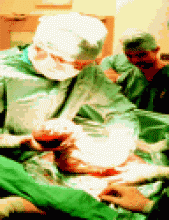- © 2004 Canadian Medical Association or its licensors
New guidelines will make it easier for North American women to opt for elective cesarean delivery, but some women's groups and international health organizations disapprove.

Figure. Cesarean section or vaginal birth: Do women have enough information? Photo by: Health Canada
Recent studies indicating that a planned cesarean delivery is as safe for the mother as vaginal delivery (see page 813), coupled with an increasing demand for the surgery, prompted the American College of Obstetricians and Gynecologists (ACOG) to publish a “committee opinion” in November 2003. It supports “the permissibility of elective cesarean delivery in a normal pregnancy, after adequate informed consent.”
In late spring, the Society of Obstetricians and Gynaecologists of Canada (SOGC) will release similar recommendations.
The SOCG guidelines won't give blanket permission for doctors to perform elective cesareans, said Acting Executive Director Dr. Vyta Senikas. “This is only for particular situations where it is at the behest of the patient, and doctors require guidance on how to deal with it.”
The guidelines were promptly criticized by natural childbirth advocates such as Lemaze International, whose president describes them as a “campaign of misinformation.” Barbara Hotelling argues that the balance of evidence shows that cesarean sections are far from safe. “Our concern is that women [are] making choices without information.”
The Canadian Women's Health Network emphasizes informed choice and accessibility to a full spectrum of options, including birthing support from doulas and midwives. Cesarean sections “should be at the end of the line, not at the top,” says chairperson Abby Lippman. “The last thing I want to do is take choice away from women, but I get very nervous when I see choices being constructed by other people.”
The more permissive attitude toward elective cesareans also runs counter to international recommendations. The International Federation of Gynecology and Obstetrics guidelines state that “Because hard evidence of net benefit does not exist, performing cesarean sections for non-medical reasons is ethically not justified.” Similarly, the World Health Organization states that a cesarean section rate of over 15% indicates “inappropriate usage.”
But many countries exceed that rate: Brazil reports rates of 32% and Hong Kong's rate reached 27% in 1999.
Senikas readily acknowledges the disadvantages of the surgery. “Ideally we'd not see cesareans at all,” she says. But even after doctors have discussed the risks “we will still be left with the odd patient who will elect for a cesarean section.”
In the United States, requests for planned cesarean delivery are becoming more common. A 2003 study showed that “patient choice” cesareans increased by 20% between 1999 and 2001, accounting for 1.87% of all deliveries or about 63 000 nationwide. There are no data on elective cesareans in Canada. Although Senikas does not perceive “an epidemic of requests,” she has seen an increase in demand. “Five years ago I'd get a request every year or two; now it's every month or two.”
Requests for elective cesarean delivery present obstetricians with a clinical and ethical conundrum. Do considerations such as avoidance of pain, fear of labour, worries about maternal complications and risks to the fetus, or the convenience of the mother, justify the risks of “unnecessary” surgery? How far should patient choice in the birthing process extend?
This is a new twist in the controversy that has surrounded cesarean delivery since the 1980s, when high cesarean rates — nearly twice those of some European countries — prompted North American obstetricians to reevaluate the practice. Canada's rate fell from a high of 20% of live births in 1986 to 15% in 1994, but then rose again to 19.6% by 1997. In the US, the rate of cesarean delivery reached an all-time high of 26.1% in 2002. – Benjamin Singer, CMAJ








